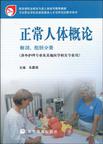正常人体概论·解剖、组胚分册
当前位置:首页 > 医学 > 基础医学 > 正常人体概论·解剖、组胚分册
出版社:高等教育出版社
出版日期:2005-8
ISBN:9787040174144
页数:414页
作者简介
《正常人体概论:解剖组胚分册(涉外护理专业及其他医学相关专业用)》是一本中、英文混编的双语教材。全书分十二章,讲述人体各器官系统的形态结构及人体发生、发育的基本理论知识,每章节包括学习目标、正文、插入框、阅读理解、小结和复习。全书各级标题全部采用中、英文对照形式。专业知识的选择和取舍以高等职业教育特点为依据,内容描述简洁易懂,层次分明,图文并茂,设计新颖。每章节的基本内容用中文描述,保证学生对解剖组胚学专业知识的掌握,各章节中的学习目标、插入框、小结和课后练习均采用中、英文对照形式,每章后按出现先后顺序附英文单词和音标索引,既有利于教师备课、学生自学和双语教学,又有利于学生专业外语水平的提升。是我国第一本针对五年制高职涉外护理专业的双语教材。
《正常人体概论:解剖组胚分册(涉外护理专业及其他医学相关专业用)》主要供五年制涉外护理专业使用,也可供五年制护理、助产、检验、药剂、卫生保健、康复、口腔工艺、影像技术等相关医学专业使用。
书籍目录
Preface(绪论) 一、Definition of anatomy,histology and embryology(解剖学及组织胚胎学的定义) 二、Organization of the human body(人体的组成) 三、Frequently used terms in anatomy(解剖学常用术语) 四、Commonly used staining in histology(组织学常用的染色法) 五、Methods in studying anatomy,histology and embryology(学习解剖学及组织胚胎学的方法) 六、Review(复习)第一章 Cell(细胞) 第一节 Cell Membrane(细胞膜) 一、Concept of the cell membrane(细胞膜的概念) 二、Chemical composition of the cell membrane(细胞膜的化学组成) 三、Structures of the biological membrane(生物膜的结构) 四、Function of the cell membrane(细胞膜的功能) 第二节 Cytoplasm(细胞质) 一、Cellular matrix(细胞基质) 二、Organelles(细胞器) 第三节 Nucleus(细胞核) 一、Nuclear membrane(核膜) 二、Nucleolus(核仁) 三、Chromatin and chromosome(染色质和染色体) 四、Nuclear matrix(核基质) 第四节 Cell Reproduction(细胞增殖) 一、Interphase(间期) 二、Mitotic stage(分裂期,M期) 第五节 Review(复习)第二章 Basic Tissues(基本组织) 第一节 Epithelial Tissues(上皮组织) 一、Simple epithelia(单层上皮) 二、Stratified epithelia(复层上皮) 三、Glandular epithelia and glands(腺上皮和腺) 四、Special structures and junctions of the epithelial tissue(上皮组织的特殊结构和连接) 第二节 Connective Tissues(结缔组织) 一、Connective tissue proper(固有结缔组织) 二、Cartilage tissue and cartilage(软骨组织与软骨) 三、Osseous tissue and bone(骨组织与骨) 四、Blood(血液) 第三节 Muscle Tissues(肌组织) 一、Skeletal muscle(骨骼肌) 二、Cardiac muscle(心肌)三、Smooth muscle(平滑肌)第四节 Nervous Tissues(神经组织)一、Neuron and neuroglia(神经元与神经胶质) 二、Nerve fibers(神经纤维) 三、Nerve endings(神经末梢) 第五节 Review(复习)第三章 Locomotor System(运动系统) 第一节 Osteology(骨学) 一、Introduction(概述) 二、Bones of the trunk(躯干骨) 三、Bones of the limbs(四肢骨) 四、Skull(颅骨) 第二节 Arthrology(骨连结) 一、Introduction(概述) 二、Articulations of bones of the trunk(躯干骨的连结) 三、Articulations of the limbs(四肢骨的连结) 四、Articulations of the cranial bones(颅骨的连结) 第三节 Myology(肌学) 一、Introduction(概述) 二、Muscles of the trunk(躯干肌) 三、MOscles of the head and neck(头颈肌) 四、Muscles of the limbs(四肢肌) 五、Muscular landmarks of the body(全身的肌性标志) 第四节 Review(复习)第四章 Digestive System(消化系统) 第一节 Introduction(概述) 一、Components of the digestive system(消化系统的组成) 二、Fundamental structures of the digestive tract(消化管的基本结构) 三、Reference lines of thorax and abdominal regions(胸部的标志线和腹部分区) 第二节 Digestive Tract(消化管) 一、Oral cavity(口腔) 二、Pharynx(咽) 三、Esophagus(食管) 四、Stomach(胃) 五、Small intestine(小肠) 六、Large intestine(大肠) 第三节 Digestive Glands(消化腺) 一、Great salivary glands(大唾液腺) 二、Liver(肝) 三、Pancreas(胰) 第四节 Peritoneum(腹膜) 一、Abdominal cavity,peritoneum and peritoneal cavity(腹腔、腹膜与腹膜腔) 二、Relationships between the viscera and peritoneum(腹膜与脏器的关系) 三、Structures formed by the peritoneum(腹膜形成的结构) 第五节 Review(复习)第五章 Respiratory System(呼吸系统) 第一节 Respiratory了ract(呼吸道) 一、Nose(鼻) 二、Larynx(喉) 三、Trachea and main bronchus(气管与支气管) 第二节 Lung(肺) 一、Location and shape of the lungs(肺的位置和形态) 二、Bronchi inside the lungs and lung segments(肺内支气管和肺段) 三、Microstructure of the lungs(肺的微细结构) 第三节 Pleura and Mediastinum(胸膜与纵隔) 一、Pleura(胸膜) 二、Mediastinum(纵隔) 第四节 Review(复习)第六章 Urinary System(泌尿系统) 第一节 Kidney(肾) 一、Location of the kidney(肾的位置) 二、Shape of the kidney(肾的形态) 三、Coverings of the kidney(肾的被膜) 四、Structures of the kidney(肾的结构) 第二节 Ureter(输尿管) 第三节 Urinary Bladder(膀胱) 一、Shape of the urinary bladder(膀胱的形态) 二、Location and relations of the urinary bladder(膀胱的位置与毗邻) 三、Internal structure of the urinary bladder(膀胱内面的结构) 第四节 Urethra(尿道) 第五节 Anatomical Features of Infant Urinary System(小儿泌尿系统的特点) 一、Higher position of the urinary bladder(膀胱的位置高) 二、Lower position of the kidney(肾的位置低) 第六节 Review(复习)第七章 Reproductive System(生殖系统) 第一节 Male Reproductive Organs(男性生殖器) 一、Male internal genital organs(男性内生殖器) 二、Male external genital organs(男性外生殖器) 三、Male urethra(男性尿道) 第二节 Female Reproductive Organs(女性生殖器) 一、Female internal genital organs(女性内生殖器) 二、Female external genital organs(女性外生殖器) 第三节 Mamma or Female Breast(乳房) 一、Location and shape of the female breast(乳房的位置和形态) 二、Structures of the female breast(乳房的结构) 第四节 Perineum(会阴) 一、Muscles of the perineum(会阴肌) 二、Important structures of the perineum(会阴的重要结构) 第五节 Review(复习)第八章 Vascular System(脉管系统) 第一节 Cardiovascular System(心血管系统) 一、Introduction(概述) 二、Heart(心) 三、Blood vessels(血管) 第二节 Lymphatic System(淋巴系统) 一、Lymph vessels(淋巴管道) 二、LNnph organs(淋巴器官) 第三节 Review(复习)第九章 Sense Organs(感觉器官) 第一节 Visual Organ(视器) 一、Eyeball(眼球) 二、Accessory organs of the eye(眼副器) 三、Blood vessels of the eye(眼的血管) 第二节 Vestibulocochlear Organ(前庭蜗器) 一、External ear(外耳) 二、Middle ear(中耳) 三、Inner ear(内耳) 四、Conduction of the sound wave(声波的传导) 第三节 Skin(皮肤) 一、Structure of the skin(皮肤的结构) 二、Skin appendages(皮肤的附属器) 第四节 Review(复习)第十章 Endocrine System(内分泌系统) 第一节 Introduction(概述) 一、Comportents and functions of the endocrine system(内分泌系统的组成及功能) 二、CIassification of the hormones(激素的分类) 第二节 Thyroid Gland(甲状腺) 一、Location and shape of the thyroid gland(甲状腺的位置和形态) 二、Microstructure of the thyroid gland(甲状腺的微细结构) 第三节 Parathyroid Glands(甲状旁腺) 一、Location and shape of the parathyroid glands(甲状旁腺的位置和形态) 二、Microstructure of the parathyroid glands(甲状旁腺的微细结构) 第四节 Suprarenal(Adrenal)GIands(肾上腺) 一、Location and shape of the suprarenal glands(肾上腺的位置和形态) 二、Microstructure of the suprarenal glands(肾上腺的微细结构) 第五节 Pituitary Gland(垂体) 一、Location and shape of the pituitary gland(垂体的位置和形态) 二、Microstructure of the pituitary gland(垂体的微细结构) 第六节 Pineal Body(松果体) 第七节 Review(复习)第十一章 Nervous System(神经系统) 第一节 Introduction(概述) 一、Division of the nervous system(神经系统的区分) 二、Active modes of the nervous system(神经系统的基本活动方式) 三、Frequently used terms in the nervous system(神经系统的常用术语) 第二节 Central Nervous System(中枢神经系统) 一、Spinal cord(脊髓) 二、Brain(脑) 三、Meninges and blood Vessels of the brain and spinal cord and circulation of the cerebrospinal fluid(脑和脊髓的被膜、血管及脑脊液循环) 四、Pathway of the nervous system(神经系统的传导通路) 第三节 Peripheral Nervous System(周围神经系统) 一、Spinal nerve(脊神经) 二、Cranial nerves(脑神经) 三、Visceral nerves(内脏神经) 第四节 Review(复习)第十二章 Human Embryology(人体胚胎学) 第一节 Preface(绪论) 一、Rcsearch scope and development of the embryology(人体胚胎学的研究范畴与发展) 二、Status of the embryology in medicine and methods of studying the science(人体胚胎学在医学中的地位与学习方法) 第二节 Dcvelopment of the Embryo and Early Growth(J~体胚胎发生和早期发育) 一、Maturation of the germ cells(生殖细胞的成熟) 二、Early development of the embryo(胚胎的早期发育) 第三节 Formation and Differentiation of Three—layered Embryo(三胚层的形成及其分化) 一、Formation of three-layered embryo(三胚层的形成) 二、Embryogenesis and differentiation of three-layered embryo(胚体的形成与三胚层的分化) 三、Tissucs and organs differentiated from three-layered embryo(三胚层分化的组织和器官) 第四节 Fetal Membrane and Placenta(胎膜与胎盘) 一、Fetal membrane(胎膜) 二、Placenta(胎盘) 第五节 Estimation of the Fetal Age(胎龄的推算) 第六节 Twins,Muhiplets and Conjoined Twins(双胎、多胎与联体双胎) 一、Twins(双胎) 二、Multiplets(多胎) 三、Conjoined twins(联体双胎) 第七节 Malformation(畸形) 一、Malformation in digestive system(消化系统的畸形) 二、Malformation in urinary system(泌尿系统的畸形) 三、Malformation in genital system(生殖系统的畸形) 四、Malformation in locomotor system(运动系统的畸形) 五、Malformation in nervous system(神经系统的畸形) 第八节 Fetal Circulation and Changes after Birth(胎儿血液循环及其生后变化) 一、Fetal circulation(胎儿血液循环) 二、Changes of the fetal circulation after birth(胎儿血液循环出生后的变化)Reference(参考文献)
前言
本教材是在全国涉外护理专业教材建设委员会的指导下,根据教育部办公厅、卫生部办公厅组织制定的《中等职业学校和五年制高职护理专业领域技能型紧缺人才培养培训指导方案》中涉外护理(英语)教育培养方案,组织全国部分开办涉外护理专业学校的骨干教师、实习医院教学负责人共同编写的。 本教材编写以高等职业教育的特点为出发点,本着创新性、科学性和适用性原则,结合学生专业岗位要求和培养学生综合职业能力的实际,确定了本教材的编写特色: 1.我国涉外护理专业创办近20多年来,始终没有针对本专业特点的适用性教材。在本教材编写中我们摒弃教材越编越厚,内容越编越深的弊病,精选内容,注重实用,并采用全新的版面设计和中、英文结合方式,突出体现教材的创新性和涉外护理专业的适用性。是高等职业教育涉外护理专业教材改革的一次大胆探索和尝试。 2.重视教材编写的科学性原则,文字表达简洁易懂。尽量删减一些深奥和与职业能力无关的内容,降低教学内容的难度。各章节中的基本内容仍用中文描述,保证了基础知识的系统性学习,同时又拓宽了本教材的专业适用范围。 3.注重涉外护理专业岗位特点和双语教学特点,每章节中的标题、学习目标、插入框、小结和术语学习均采用中、英文对照形式,每章后附有英文多项选择题或填空题。英语单词索引按出现的先后顺序编排,易于教师备课和学生自学。 4.重点名词术语第一次出现时均采用中、英文对照形式。再次出现时,只用英语表示,使学生每学一个章节,都能掌握一些重点英文术语,为以后的双语教学打下坚实的基础。 5.每一章中的中、英文对照都置于醒目的框框内,框中的内容均为本章重点。既可使学生掌握重要知识点,又可提高医学英语阅读能力。 本教材的编写得到了西安卫生学校、福建省卫生学校、承德卫生学校、鞍山师范学院附属卫生学校和四川省卫生学校的大力支持,在此深表谢意。 由于编者水平有限,在教材编写和英语运用方面难免有不妥之处,恳请使用本教材的师生提出批评改正意见。
章节摘录
构成人体的基本结构和功能单位是cell(细胞)。由于细胞的功能及所处的位置不同,构成人体的细胞形态各异,如能接受刺激并传导冲动的神经细胞有长的突起,在血管内能流动的血细胞呈球形或圆盘状。许多形态相似、功能相近的细胞借细胞间质结合在一起构成具有一定功能的结构,称为tissue(组织)。人体的基本组织按其结构和功能可分为四种类型,即上皮组织、结缔组织、肌组织和神经组织。由几种不同的组织有机地结合,构成具有一定形态结构、完成特定功能的organ(器官)。许多结构上连续、功能上相关的器官连接在一起,构成能完成连续生理功能的system(系统)。人体由九大系统组成:即运动系统、消化系统、呼吸系统、泌尿系统、生殖系统、脉管系统、感觉器、神经系统和内分泌系统。其中消化、呼吸、泌尿和生殖系统,除个别器官外,大部分器官都位于胸腔、腹腔和盆腔内,并通过一定的通道和外界相通,总称为viscera(内脏)。 人体虽然是由九大系统组成,但每个系统中的各个器官又有其特定的形态和功能,在神经和体液的调节下,人体各系统之间既相互影响和制约又相互依存和协调,从而构成一个完整统一的有机体,共同完成正常的功能活动。 按照人体的外形,人体可以分为头、颈、躯干和四肢四部分。躯干部又可分为胸部、腹部、背部和盆部。四肢又分为上肢和下肢。
图书封面
